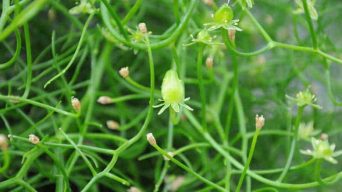Succulents come in a wide range of shapes, sizes, and care requirements.
One exciting type is called the Fishbone Cactus or Ric Rac Cactus.
It gets its name from its appearance: two curved fishbones with each spine coming to a pointed end.
This cactus is often used as decoration because of its unique look, making a very interesting houseplant.
If you have trouble keeping plants alive, this care guide is for you.
Overview
The Ric Rac Cactus, also known as the Fishbone Cactus, is a flowering succulent plant native to Chiapas, Mexico.
This plant grows as an epiphytic plant (a plant that lives on another but is not parasitic) in dense clusters that fall dramatically from tree trunks.
The Ric Rac Cactus has dark green, smooth skin, and long, branching stems growing up to 20-30 cm long and 3-5 cm wide.
The main stems are generally woody, and the secondary stems are flat, fleshy, with serrated and lobed shapes.
The flowers of this night-blooming cactus are white or pale yellow and have a pleasant, sweet fragrance. Their average size is between 6 and 20 cm long, with a 6 and 7cm width.
The fruits are oval, brown, green, or yellow, measuring 3-4 cm long and 2 cm in diameter.
The tasty fruit’s green pulp and tiny black seeds are comparable to those of kiwifruit.
The scientific name for this cactus species is Disocactus anguliger, formerly called Epiphyllum anguliger, which is generally known by the following names:
- Fishbone Cactus
- Ric Rac Cactus
- Zig Zag Cactus
- Ric Rac Orchid Cactus
- Rick Rack Cactus
How To Care for Ric Rac Cactus
Ric Rac Cactus care is relatively easy. However, to get the best results, it is essential to have some basic knowledge about this succulent plant.
The essential information about caring for Fishbone Cactus can be found below.
Sun Exposure & Light Requirements
The Fishbone Cactus is a succulent plant that thrives in bright indirect light.
If the “arms” of your cactus start to lose their color, it could be because it’s in a dark area and not getting enough light. Try moving it to a brighter spot.
Like many other types of cacti and succulents, this plant needs at least four hours of direct sunlight every day.
However, the succulent may get sunburned if it’s in direct sun for too long.
It’s best to keep it in a spot that gets morning sunlight, with shade in the afternoon.
Ensure not to put it in an area where the sun will be blasting down on it with no shade all day.
When growing a Ric Rac Cactus indoors, it’s best to place it in a south or west-facing window, where it will get plenty of indirect sunlight.
When growing a Fishbone Cactus outdoors, it’s best to place it in a spot that gets full sun exposure during the morning hours and then shade during the afternoon.
Watering Requirements
The Ric Rac cactus is a succulent plant, so it doesn’t require a lot of water. In fact, overwatering can be very harmful to the plant.
Water your cactus once every 1 to 2 weeks during the summer and once every 4 to 6 weeks during winter.
When watering, be sure to give the plant a good soaking, letting the water drain through the pot’s drainage hole. Then, allow the pot to dry out before watering again.
Avoid getting the cactus’ leaves and stem wet, which can lead to fungal growth. Only water the soil.
Soil Requirements
A Fishbone Cactus plant grows best in a well-draining soil mix.
You can create your own mix or purchase a succulent and cactus mix. The soil should be light and sandy.
To make your own soil mix, combine one part potting soil, one part perlite, and one part sand.
Perlite is a white, sterile volcanic rock that looks like small pebbles. It is lightweight and used as an additive to potting soil so that it will drain more easily.
Sand is optional but will help keep the soil mix from becoming too compacted.
If you use a commercial cactus mix, ensure it does not contain fertilizer.
Ric Rac Cacti do not need supplemental fertilizing; too much can burn their roots.
Temperature and Humidity
Because the Ric Rac Cactus is a tropical succulent, the ideal temperature ranges from 68 F – 84 F (20 to 28 C) during the day and 55 F – 65 F (13 to 18 C) at night.
Avoiding drafts and providing good air circulation to prevent fungal problems is important.
The humidity level for the Fishbone Cactus should be kept around 50%.
If the humidity is too low, the leaves will start to curl inward as they lose moisture. If the humidity is too high, the plant can develop fungal problems.
Fertilizing
The Fishbone Cactus is a fast-growing plant that doesn’t need very much fertilizer.
You can fertilize your Ric Rac every other month during the spring and summer months.
A water-soluble cactus or orchid fertilizer will work the best. Only use one scoop per gallon of water and feed about once a month during the spring and summer.
If you use cactus fertilizer, mix it with water before watering your Ric Rac.
Over-fertilizing your succulent can cause them to become highly flimsy, slim, and weak.
If you are ever in doubt, it’s best to err on the side of caution and not fertilize at all.
Potting and Repotting
Like most succulents, the Fishbone Cactus does best when slightly pot-bound.
Repot only when necessary, and use a pot that is only one size larger than the current pot.
The Ric Rac Cactus does not need to be repotted frequently and can often go a couple of years between repotting.
When repotting, use a well-draining potting soil mix, and be sure not to water for at least a week.
Be careful to remove as much of the old soil as possible and provide fresh soil.
When transplanting, be sure to take great care to avoid breaking or injuring any root systems (you can see the roots by holding up the plant and gently shaking it).
The best time to repot a Ric Rac Cactus is in the spring when new growth has begun.
However, if you live in a hot or dry area, fall might be a better time to do it so that the plant can rest over the warmer months.
Pruning
Fishbone Cactus plants are fast-growing and can quickly outgrow their pot or garden space.
Regular pruning will help keep them healthy and looking their best.
Prune off any dead or damaged branches using sharp scissors or a knife, and cut back any long or spindly branches to keep the plant bushy and compact.
By removing old or damaged branches, you also remove the possibility of any pests or diseases from spreading to healthy parts of the plant.
Remember always to use clean, sharp tools to prevent any spreading of disease.
Pests and Diseases
Fishbone cacti are generally very hardy and easy to care for, but like any other plant, they can be susceptible to pests and diseases.
Spider mites and mealybugs are the most common pests, while root rot and fungal diseases are the most common diseases.
Mealybugs
Mealybugs are tiny, sap-sucking insects that can cause yellowing and browning of the leaves, stunted growth, and even death.
They can be controlled with regular applications of horticultural oil or insecticidal soap.
Spider Mites
Spider mites are tiny arachnids that feed on the sap of plants.
They are nearly impossible to see without magnification, but you can often tell if these bugs are devouring your plant by the fine webbing they produce.
Spider mites are best controlled with insecticidal soap, neem oil, or a light horticultural oil spray.
Root Rot
Fishbone cacti are desert plants and do not like wet soil. If the soil is too wet, the roots can rot, which will cause the plant to wilt and die.
To prevent root rot, ensure your cactus is planted in well-draining potting soil and water it sparingly.
Fungal Diseases
Fungal diseases can be a problem for any plant, but they are particularly common in succulents.
These diseases can be identified by the presence of white, powdery patches on the leaves or stems.
They can be treated with a fungicide spray or by removing and destroying infected parts of the plant.
How to Care for Fishbone Cactus in Winter
Fishbone Cactus, also known as Ric Rac Cactus, is among the easiest succulents to care for.
However, when it comes to its winter care, not much attention is given to this type of cactus because most people think they can do nothing about their Ric Rac Cactus in Winter.
However, like all other succulents, Fishbone Cactus still needs special winter care.
Here are a few tips on how to take care of your Ric Rac Cactus during winter:
- Ensure the plant is in a cool, dry place without exposure to cold drafts. A temperature range of 50-60 degrees Fahrenheit is ideal.
- Reduce the watering frequency, but do not stop watering altogether. The plant should be watered only when the soil feels dry to the touch.
- Avoid fertilizing the plant during winter.
- Bring the plant inside if the temperature falls below 50 degrees Fahrenheit.
- If you see any sign of frost damage, carefully remove and discard any affected parts of the plant.
- If any plant branches lose their leaves during winter, don’t prune them just yet – wait until early spring. If you prune now, you’ll risk damaging or even killing your plant.
The most feared problem for winter care of Fishbone Cactus is the occurrence of rot.
Possible reasons for this are prolonged exposure to cold drafts and low humidity that often accompanies dry air heating systems.
To prevent the soil from getting too wet, you should add some gravel or broken pots to the potting mix before planting your Fishbone Cactus.
How To Propagate Ric Rac Cactus
The Ric Rac Cactus is an easy plant to propagate and can be done either by stem cuttings or by division.
Propagating Fishbone Cactus by cuttings is the most common method.
Stem Cuttings
Stem Cuttings is the most popular propagation method for Ric Rac Cactus. They are easy to take and root quickly with little or no loss.
To propagate Fishbone Cactus from cuttings:
- Cut a healthy stem from the parent plant at least 3-4 inches long.
- Let the cut end dry out for a day or two to form a callus.
- Dip the callused end into rooting hormone powder.
- Stick the cutting in moist potting soil.
- Keep the soil moist and place the cutting in indirect sunlight.
- After several weeks, you should see roots forming.
- Once the cutting has developed its own root system, it can be transplanted into a new pot with fresh soil.
Division
Another way to propagate Ric Rac Cactus is by division. This can be done when the plant grows too large for its pot or creates more plants.
To propagate Fishbone Cactus by division:
- Remove the plant from its pot and gently loosen the root ball.
- Use a sharp knife to slice through the roots vertically, from top to bottom. Do this all around the circumference of the plant.
- Replant the Ric Rac Cactus in a small pot with fresh soil and keep it well-watered until new growth begins.
- Once four or five new leaves have formed, the plant can be moved to a larger pot if necessary.
Final Thoughts
Fishbone Cactus care is not difficult, but there are a few things to keep in mind.
Be sure to water only when the soil is dry to the touch, and give the plant plenty of bright light.
Ric Rac Cactus plants can be propagated easily from cuttings, so if you have any extras, go ahead and try that method.
Be sure to keep your plant out of direct sunlight, as it can brown the leaves.
Taking care of a Fishbone Cactus is a fun and easy way to add some succulent color to your home or garden. This plant should grow into a large, bushy specimen with proper care.







